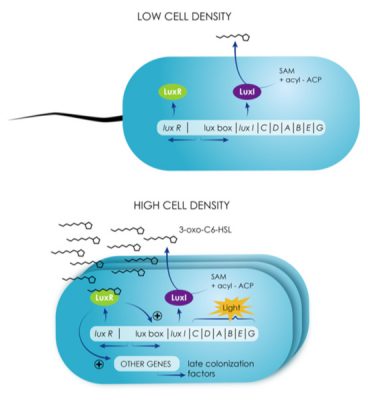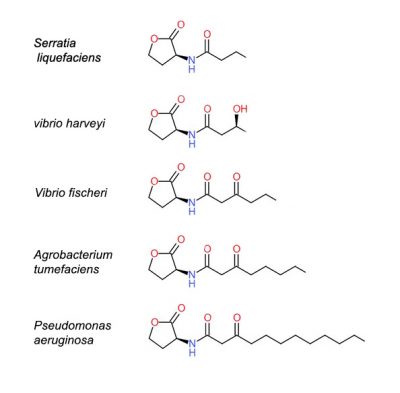Quorum sensing and chemical messengers
PDF1. Induction of the synthesis of chemical messengers during quorum sensing

- At low cell density, the low concentration of chemical signals from quorum sensing (“self-initiators”) binding to a cell receptor before being locally eliminated has little effect on cells, which in response synthesize and emit few self-initiators and other associated molecules.
- -Above a certain threshold, the concentration of self-injectors is sufficient to stimulate the cells to switch to another mode of functioning, of the “social” type, involving a significant modification of gene expression.
In the case illustrated in Figure 1, the enzyme LuxI (autoinducer synthase) governs the synthesis of autoinductors. The LuxR receptor captures them and regulates the expression of lux genes involved in bioluminescence production.
2. Which compounds are involved in quorum sensing?
The research and identification of the compounds involved in quorum sensing, as well as the characterization of the functions they regulate, require the coupling of many experimental approaches from different disciplines: natural substance chemistry, cell biology, biochemistry, genetics or genomics. The low concentration of these compounds makes very difficult to find them within natural samples [1]. These compounds are therefore often studied in representative strains, microbial models. One of the first steps is to verify that these collection strains are capable of producing quorum sensing molecules, using genetically modified organisms called biosensors which emit fluorescence or purple coloration in the presence of self-initiators.
If these biotests are positive, the natural substance chemistry approaches (Gas Phase Chromatography (GPC) or High Performance Liquid Chromatography (HPLC), coupled with Mass Spectrometry (MS/MS) and Nuclear Magnetic Resonance (NMR) can be used to characterize the compounds produced. The identification of the functions regulated by these compounds is often based on the production of mutants of quorum sensing pathways in the model strains studied. The genes involved in molecular dialogues are inactivated and the phenotypes induced in these mutants are characterized, i.e. the behaviour, growth and activity of the microorganism in which these genes are inactivated are observed [2].
3. Nature of chemical messengers: the basics of bacterial language

More recently, it has also been demonstrated the importance of furanosylated borate diester in these exchanges, a small molecule with two carbon rings that contains a boron atom [3]. Since then, many other compounds have been identified, but microbiologists agree that only a tiny fraction of the chemical signals exchanged during quorum sensing by microbial cells are still known. These compounds are emitted in very small quantities, which makes their identification particularly uneasy.
Notes et références
[1] Hmelo L, Van Mooy BAS (2009) Kinetic constraints on acylated homoserine lactone-based quorum sensing in marine environments. Aquat Microb Ecol 54 :127-133.
[2] Rolland JL, Stien D, Sanchez Ferandin S & Lami R (2016). Quorum sensing and quorum quenching in the phycopshere of phytoplankton : a case of chemical interaction in ecology. Journal of Chemical Ecology 42:1201-1211.
[3] Chen X, Schauder S, Potier N, Van Dorsselaer A, Pelczer I, Bassler BL & Hughson FM (2002). Structural identification of a bacterial quorum-sensing signal containing boron. Nature 415(6871):545-549




